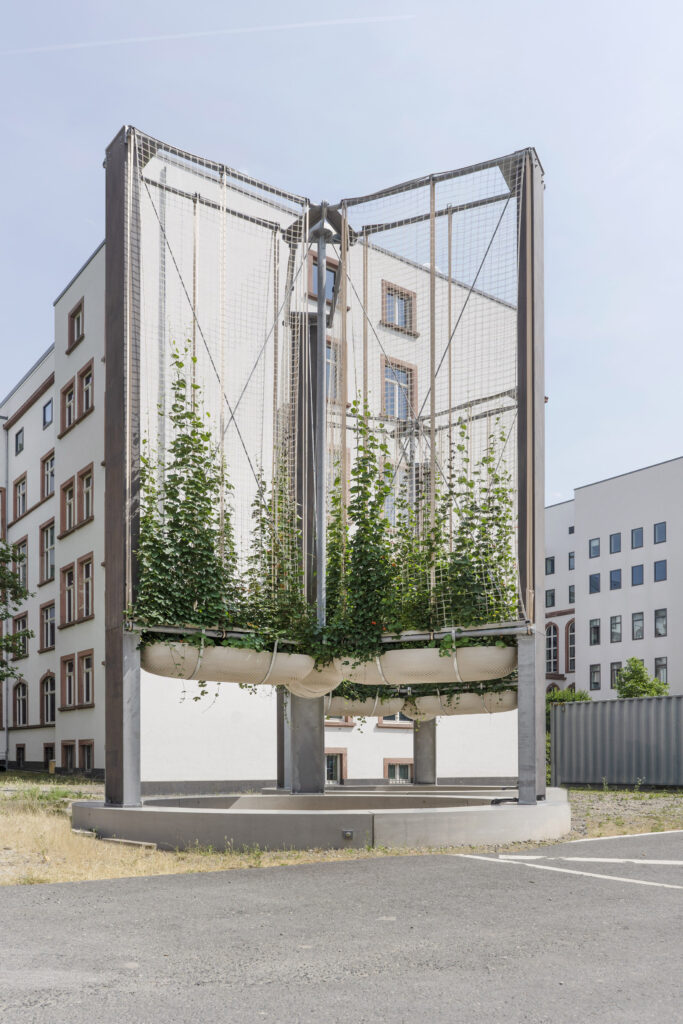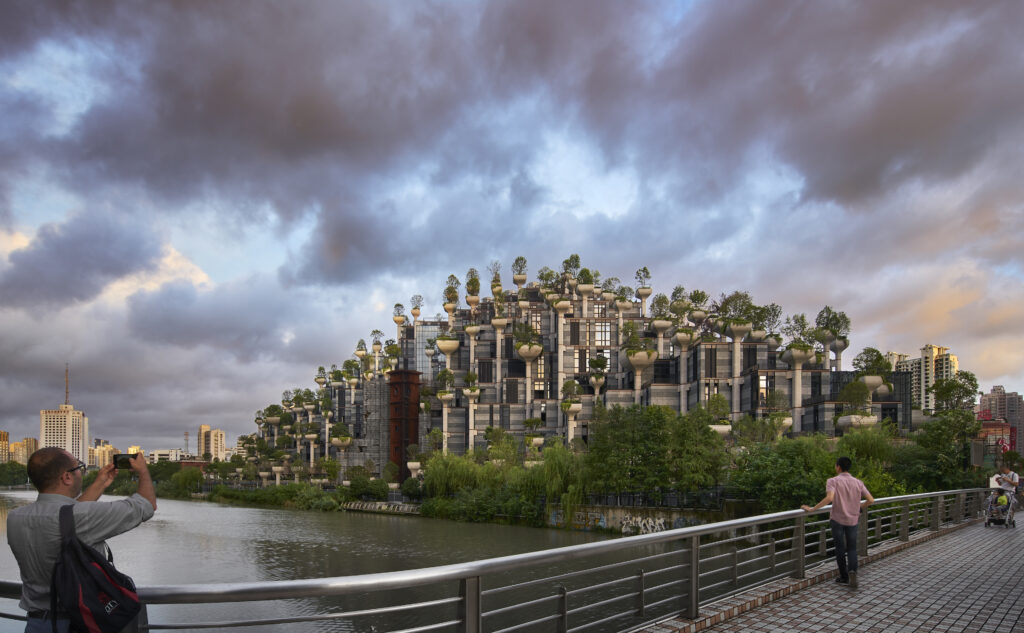Since this summer, “VERD°” has been standing in Frankfurt am Main: as a prototype of a serial, tree-like structure that is supposed to provide cooling in cities plagued by increasing heat. An attempt to make cities more climate-silient with new, green architecture – and an occasion to ask what is really needed for a “Green City”.
By Martina Metzner

Worldwide, cities such as Singapore, Paris or Frankfurt am Main have taken on the task of greening their areas more strongly under the motto “Green City” in order to counteract the rising summer temperatures caused by climate change. Because in cities, the heat increases even more than elsewhere due to the heat-storing effect of asphalt and concrete. Increasingly, heat islands are created that do not cool down even at night. Forecasts show that in some metropolises it could be up to eight degrees Celsius warmer in 2100 than it is today. But urban greenery should also help against other weather extremes such as heavy rain or storms. In this context, urban planners have the principle of the sponge city in mind, in which areas store water and release it again when needed, as Copenhagen already implemented years ago. But urban green is not only an important factor in climate adaptation: greenery helps to combat noise and fine dust pollution, increases biodiversity and, last but not least, contributes to the relaxation of stressed city dwellers.
Trees as the Most Effective Urban Green
There are many ways to green cities. The most effective is to plant trees: they provide shade as well as moisture and thus ensure cooling. This natural air conditioning can reduce the temperature in the immediate vicinity by a perceived one to eight degrees Celsius. In addition, a fully grown urban tree can process 12.5 kilograms of CO2 and produce 4,600 kilograms of oxygen per year – and thus contributes to achieving the climate goals. However, space for trees is scarce, especially in city centres, because they compete with buildings and streets and also need a lot of root space – ideally around 36 cubic metres.
Alternative for Dense Substrate
Therefore, alternatives are desperately sought. One of these has been in place since this summer in the backyard of the Senckenberg Research Institute and Natural History Museum in Frankfurt am Main. Two plants made of wood and reinforced concrete rise 10 metres into the air, with native and non-native climbing and creeping plants such as bell vines, morning glory, hops and nasturtiums stretching out towards the sun on their flax ropes. The two “design trees” called “VERD°” are the first prototypes; the Senckenberg Research Institute and the German Meteorological Service are continuously collecting data to study the effectiveness of the plant. Behind the project is concentrated design power: the Office for Micro Climate Cultivation, or OMC°C for short, was founded as a start-up by Nicola Stattmann and Carlotta Ludig in 2020. The two Frankfurt designers also brought on board the designer Stefan Diez, the architect Malte Just from Just Architekten, the engineering firm Bollinger + Grohmann and the gardener Dieter Gaißmayer. Together they are entering a field that is traditionally played by landscape architects and garden and landscape construction companies.The team wants to place the recyclable “VERD°” plant in places where there is little space for trees and especially their roots: i.e. in areas with a high density of underground infrastructure such as sewers, pipes or underground car parks. The raised planting troughs made of 3D-printed, recycled plastic allow people to walk underneath the structure. Irrigation is automatic, a water and electric connection is a prerequisite. At the end of the season, the team harvests the annual plants to reuse the biomass, for example for activated carbon. In winter, the stelae remain empty – the team has not yet found an answer to the question of how they can be used during this time and frowns when asked about Christmas lighting. Maintenance is very specific and is therefore taken over by OMC°C, say Ludig and Stattmann. They are already in contact with some municipalities.

OMC°C are not the only ones to offer such free-standing, vertical climbing aids for urban spaces. Since 2016, for example, the provider Helix from Kornwestheim has had a “mobile green room” on the market, which it developed together with the Office for Landscape and Architecture (OLA) from Stuttgart and which is on the road as a rental object in 25 German cities. The advantage: the plant room is self-sufficient, thanks to a large water tank and a solar system that supplies the electricity for the water pump. Permanently installed, on the other hand, are the free-standing climbing aids offered by Jakob Rope Systems from Switzerland. The pergola at Einstein-Platz in Aarau, Switzerland, is very similar to the “VERD°” system in terms of construction and height: here, too, the steel girders have to be anchored in a round concrete foundation to compensate for the wind loads. Compared to the Frankfurt facility, however, the climbing plants here are ground-based – which makes irrigation easier and more sustainable, as rainwater is used here instead of drinking water and no electricity is needed.
Pioneer Bosco Verticale in Milan
“VERD°” is thus one of a series of new vertical urban greening concepts that start where space for trees is scarce. Above all, it is new types of façade and roof greening that make buildings look as if they had been left to nature for years and are reminiscent of the legendary hanging gardens of Semiramis in Babylon. Patrick Blanc marked the beginning of this movement, starting in Paris, with his dense and lush carpets of plants on the walls of buildings, but this worked mainly as an add-on. This changed abruptly with the “Bosco Verticale” (vertical forest) high-rise complex in Milan, which opened in 2014. Here, architect Stefano Boeri and landscape planner Laura Gatti placed plants at the centre of the architecture: 800 mature trees and 20,000 other plants thrive on the balconies of the two 80 and 110 metre high towers. In the meantime, more than ten other “vertical forests” have been realised or are being planned worldwide.

Germany is also caught up in this new wave of green architecture: The emblematic Kö-Bogen II in Düsseldorf, completed in 2021, with its 30,000 hornbeam hedges around the entire building, was designed by Christoph Ingenhoven, who also greened the façade of the Calwer Passage in Stuttgart. Along with Stefano Boeri, Thomas Heatherwick and Edouard Françoise, the Düsseldorf architect is one of the most popular international architects of green buildings. However, these concepts are not really new. In 1968, for example, the architect Ot Hoffman designed a house in Darmstadt whose trees and shrubs still sway magnificently over the balcony railings. Hoffmann’s tree house was just one example of the design expression of the then new environmental movement, which resulted in terrace houses full of bushes – or in artistic interventions such as the transplantation of 15 “tree tenants” into flats by Friedensreich Hundertwasser for the Milan Triennale in 1973.

Criticism of green architecture
But the new green architecture is not free of criticism. For example, the project to convert the old flak bunker in Hamburg’s Wilhelmsburg district into an accessible park. According to urban planners and experts from the BUND, the additional reinforced concrete construction of the extension would consume as much CO2 as the trees installed there would take hundreds of years to pay off. The “Bosco Verticale” is also being targeted: Described as a “noble forest for high earners” (brand eins) and with a recently analysed rather poor ecological balance. The architecture critic Oliver Wainwright of The Guardian also never tires of declassifying green projects such as “Tree of Trees” by Thomas Heatherwick or “Marble Arch Mound” by MVRDV, both in London, as “green washing”.
What is the truth of this criticism? Ferdinand Ludwig, founder of OLA (Office for Living Architecture) and professor for Green Technologies in Landscape Architecture at the Technical University of Munich, takes a differentiated view of the discussion. “You have to distinguish between the contribution of greening measures to climate protection on the one hand and climate adaptation on the other,” says the architect with a doctorate. Non-ground-based façade greening always leaves a negative CO2 footprint, especially if additional technical facilities have to be built for it or the building structure has to be reinforced. And when it comes to climate adaptation, individual measures would hardly make a difference. Even the “Mobile Green Room” designed by Ludwig himself, with a vertical green area of 12.5 square metres, hardly changes anything in the local microclimate and certainly nothing in the urban climate, the scientist explains, because the small, mobile green unit provides only little shade, which is the “most important cooling capacity of trees”, and hardly any cooling moisture. “But it is a symbolic and meanwhile successful means of entering into dialogue with people”. And what psychological effects it has – keyword “perceived temperature” – can hardly be measured. “Ultimately, only a comprehensive restructuring will help to make the city more climate-silient,” Ludwig says. A study by the Technical University of Munich from 2022 shows that the proportion of green space in cities must be at least 40 per cent in order to significantly reduce the heat in cities. Currently, it is at an average of 15 percent in European metropolises.
Unsealing as a Magic Word
So what really helps against the increasing heat and threatening storms in the cities? The unsealing of surfaces seems to be the magic word here. This is a dilemma for cities that at the same time want to increase density to create more living space. One lever could lie in the mobility infrastructure. If inner cities became car-free, asphalt strips could be transformed into flourishing landscapes. The “Wanderbaumallee” initiative, for example, has been campaigning for this in many cities for several years by planting mobile trees in car parks.

Promotion of Green Facades and Roofs
In addition to urban land, private areas and buildings are increasingly becoming the focus of the “Green City” movement. Many municipalities have already launched programmes to financially support private greening of facades and roofs. In Frankfurt am Main, for example, the environmental agency contributes up to 50 percent of the costs and a maximum of 50,000 euros to such projects. Another possibility is stricter legal requirements such as the ban on gravel gardens or binding requirements for greening new buildings and existing ones – Frankfurt am Main is also a pioneer in this area. All of this must be planned and implemented in a larger strategy together with the grey and blue infrastructure, says Ferdinand Ludwig – referring, for example, to the value and management of rainwater and wastewater instead of drinking water for irrigation. In this complex undertaking, individual measures such as the “Mobile Green Room”, “VERD°” or the high-rise forest buildings act as ambassadors and image bearers – and above all feed the longing and hope for more green in the city.
Meet Nicola Stattman from OMC°C, the design studio behind VERD°, live – and many other interesting protagonists from branding and design: This opportunity is offered by the GDC Summit 2023 on 9 November, 9 a.m. – 6 p.m. at the Porsche Museum Stuttgart!
Further information, detailed programme and registration
More on ndion
More articles on the topic of design and sustainability.
Share this page on social media:

